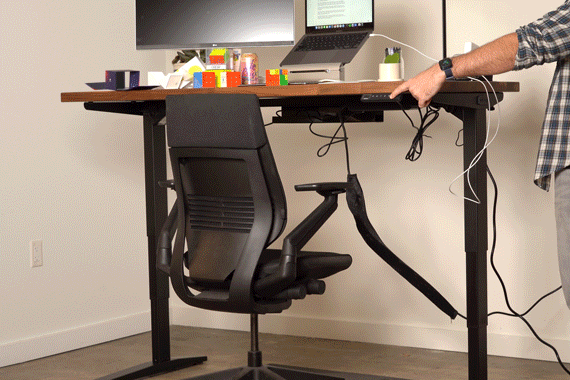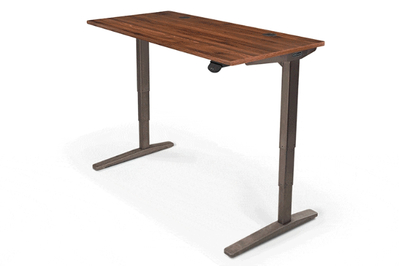The Uplift V2 Standing Desk Can Help Your Back, Lift Your Mood, and Elevate Your Home Office

Melanie Pinola is a writer focused on home-office gear. To find the best paper shredder, she has shredded enough junk mail to fill several bathtubs.
As much as I love my Steelcase Gesture office chair, I know that sitting for extended periods isn’t great for my body. I also know that standing all day (like at a permanent standing desk) isn’t ideal either. That’s where my Uplift V2 Standing Desk comes in. With the touch of a button, I can raise or lower the desktop to the proper height. This desk allows me to stand during meetings, for example, or when I’m brainstorming ideas and want to pace. Then I can sit in the afternoons, when I have post-lunch fatigue.
I tested the Uplift V2 and five other standing desks in my dining room, raising and lowering the desk to the maximum and minimum heights, as well as to various intervals in between, to simulate different people’s heights. I stood on an aerobic step platform to magically transform my height from 5-foot-2 to 6 feet. I used a Groot bobblehead to evaluate wobbliness. And I compared desktop samples from Uplift and other manufacturers. In other words, I spent a lot of time considering the desk.
Our pick
The Uplift V2 is the most customizable desk we’ve ever tested, and its wide height range works for people from 5 feet 4 inches to 7 feet tall.
The perks justify the price
Like many others, I’ve balked at the steep price of a standing desk. But if you consider how much time you spend at your desk, the investment pays off.
Buying a pricier desk to help you achieve much-needed movement is, I think, worth it in the long run. A desk is the biggest piece of furniture in a home office, and it’s one you’ll spend a lot of time looking at and working on. Personally, I spend too much time outside of work sitting, whether I’m eating, reading, or watching television with my family. So a standing desk encourages me to switch positions more frequently than I would if I had a manual-crank standing desk or no standing desk at all.

Most traditional desks are between 28 and 30 inches in height. This is best for people who are 5-foot-10 or taller—which I am not. Since I’m a petite woman, for me the Uplift V2 is actually a better desk for sitting compared with the standard desk I had before. It allows me to keep my feet on the floor (a recommendation from the ergonomists I’ve talked to). Trust me, having your feet dangling for any bit of time is uncomfortable and distracting.
And I found after testing that the Uplift V2’s quick, smooth adjustment (a pleasant whir, versus other desks’ groans) and its many customization options make it a good fit as the centerpiece of nearly any office. If money were no object, I would’ve gone with one of Uplift’s stunning hardware tops—upgrades from the basic laminate options to solid wood acacia, walnut, and fir that could cost over $1,000 for the desktop alone. But the 4-foot bamboo top I have is lovely and elegant too. I also appreciate the free accessories offered with the desk—particularly the wooden desk organizer, since the desk has no drawers.
Although it’s a fairly large desk with a steel base, setup was easy enough for me to do myself. The only trouble I had was getting the heavy boxes inside my home and turning the desk over once I’d attached the legs to the top. For that, it’s helpful to have a friend help out.
How it compares
We’ve tested more than 25 standing desks over the past eight years. Since we started testing it in 2018, the Uplift V2 has been a top pick. This is why we love it:
- It has the most customization options, so it fits into different office environments.
- It accommodates people 5-foot-4 and taller. If you’re shorter than that, we recommend the Fully Jarvis desk with extended frame.
- It’s one of the most stable standing desks at all heights. I’ve sat on the desk while raising and lowering it—without fear of it collapsing!
Read more in our guide to the best standing desk.
Make sure to schedule time to stand
A standing desk is a big investment, so it’s important to actually use it as intended. Alternate sitting and standing throughout the day. You might even make this a habit by setting distinct times for standing (at the start of the day, for example) and sitting (perhaps during meetings or short breaks). Researchers from the University of Waterloo in Ontario studied lower-back pain in people who both sat and stood at their desks, and they recommend a sit-to-stand ratio between 1:1 and 1:3. In other words, you should sit and stand for equal periods of time each day. Or, at the highest ratio, sit for 15 minutes and stand for 45 minutes every hour.
If you have problems with the desk, don’t be afraid to contact the company. Uplift offers a 10-year warranty on its desks.
The latest version of this article was edited by Rachelle Bergstein.
Meet your guide
Melanie Pinola covers home office, remote work, and productivity as a senior staff writer at Wirecutter. She has contributed to print and online publications such as The New York Times, Consumer Reports, Lifehacker, and PCWorld, specializing in tech, work, and lifestyle/family topics. She’s thrilled when those topics intersect—and when she gets to write about them in her PJs.


